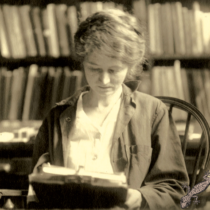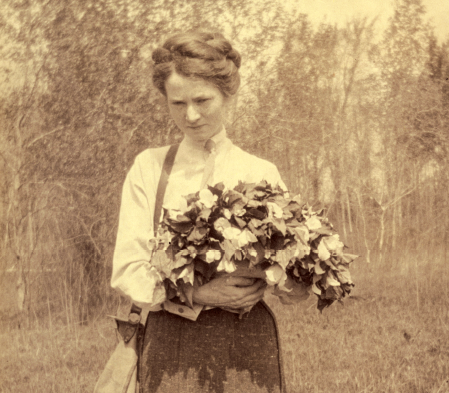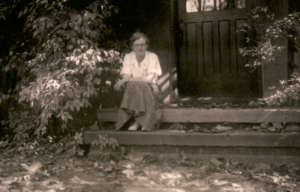Magazine

The Improbable Herpetologist
Helen Thompson Gaige’s passion for frogs, salamanders, lizards and more was unusual for a woman at the turn of the century. She defied gender stereotypes by becoming an expert in zoology and launching herself into globetrotting adventures to collect and study specimens. Her scientific legacy endures in the archive—and beyond.
By Madeleine Bradford
Growing up in the middle of Michigan’s “Thumb” in the 1890s, Helen Thompson was born into a changing world. Railroads unfurled across the country, the use of electric lights was slowly spreading, and more and more women were pursuing higher education.
Helen’s father was able to encourage her studies. A believer in the importance of education, Charles E. Thompson, widely known as “Charley,” had attended Goldsmith, Bryant & Stratton, a small business college in Detroit. He was well known for trying his hand at a wide range of local jobs in the town of Bad Axe, from bookkeeper to probate judge. Helen watched her father throw himself into new pursuits with determination, again and again.
She decided to follow her father’s footsteps: she would get a degree.
Two, in fact.
She applied to the University of Michigan and was accepted in 1906.
By 1907, Helen had discovered the U-M Museum of Zoology, and within it, the reptiles and amphibians collection. A detailed history of U-M, called the Encyclopedic Survey, notes that Helen was seen as “a student of natural history.” After earning her Bachelor of Arts degree in 1909, a teacher’s certificate, and her Master of Arts in 1910, she applied for a position at the Museum of Zoology.
It was an unusual choice in the early 20th century. Of the 20 Master of Science degrees awarded by the University of Michigan in 1910, only one was awarded to a woman.
“We know very little about the early women of science,” Margaret Rossiter writes in “Women Scientists in America before 1920,” published in American Scientist magazine. What is verifiable is that “they had fewer job opportunities and lower status, were more often unemployed, and less often considered eminent by their fellow scientists.”
The academic journal Ichthyology & Herpetology notes that Helen was “among the first professional women herpetologists in the United States.”
The Sea Serpent and the Explorer
Helen obtained her position at the U-M Museum of Zoology “by enthusiasm and competence,” according to the Encyclopedic Survey.
Her fieldwork and publications were regularly reported on in The Michigan Daily. The paper even asked her about the Loch Ness Monster.
“These stories about sea monsters appear quite frequently, but we have yet to see one,” she said. “People are inclined to exaggerate the size of snakes that they may see. They are so frightened at seeing a snake of any sort that its size increases in their imagination.”
The water would be far too cold for a sea snake in Scotland, she insisted. (She then gave a short lecture on how sea snakes swim.)

Helen, pictured with an armful of ivy in this undated photo, conducted fieldwork at home and abroad. [Frederick M. and Helen T. Gaige photograph collection]
Helen’s passion for learning drove her outdoors, starting with a 1912 expedition to Nevada, to make some discoveries for herself.
Soon enough, she was happily swooping a long-handled dip-net into muddy streams, searching for frogs.
In 1913, Helen married Frederick Gaige, a fellow museum professional. However, marriage didn’t mean leaving her job, as it did for many women at the time. According to several sources, she and her husband enjoyed their work and collaborations, which included widespread research travels. The couple went to the Davis Mountains of Texas in 1916, and the Olympic Mountains of Washington in 1919.
“Both she and Professor Gaige are real people, tireless workers, out every day, not a miss, paying no regard to weather, more and more enthusiastic over their catches; their whole aim was to add something more to their collection. And they were unreservedly liked by all who knew them,” U-M alumnus J.B. Smedley said in the 1923 Saginaw News.
That same year, in 1923, they also made their way to the Chiriqui Mountains of Panama.
The Misfire and the Miracle
Panama was hot, tangled with forests, and the Gaiges pushed gamely through them.
The noise of the shot that took Helen’s finger was muffled by undergrowth. Frederick Gaige stumbled hurriedly to the scene, and found his wife, staring in shock at her hand. Both Helen and Frederick habitually carried guns when exploring.
Helen’s had misfired.
Helen bore the pain silently at first: “Not a cry nor a whimper from her,” her husband wrote. “She showed unbelievable courage every minute.”
A doctor gave her morphine, but her fever quickly skyrocketed. “She was white and her eyes got such a terribly tired look, every time I had to leave the room she started singing a soft little song to herself,” Frederick remembered. “It was the most heartbreaking thing I ever saw.”
Telegraphs were urgently sent, but there weren’t many medical supplies readily available in the middle of the wilderness, and the chances of anything reaching them in time were slim.
It began to look like she might die there.
Then, there was what Frederick Gaige called the “miracle.”
A buzzing overhead.
It was a U.S. plane, dropping a tetanus vaccine nearby, “wrapped with tire tape and weighted.” It saved Helen’s life.
She lost her finger, but she survived the trip. Her injury certainly didn’t stop her from continuing her life’s work. It didn’t even stop her from traveling. She would go on expeditions in Florida and Colorado only two years later, in 1925.
Still, her husband’s notes about the incident show the kind of underestimation she sometimes dealt with, even at home.
In several instances, in a tone of sympathy, he called her a “child.”
Specimens and Scientific Camouflage
Helen’s colleague Alexander Ruthven described Helen as someone who applied herself to her job with gusto, uplifted colleagues, and loved sharing what she knew.
“Her careful work and sound judgment are well known,” he wrote. “With a total lack of professional jealousy, she has not only contributed directly to knowledge of the subject but has had a prominent part in improving techniques, in promoting the work of others, and in developing an esprit de corps among investigators.”
The Museum of Zoology newsletter, The Ark, joked in 1922 that, when handling new creatures being added to the collections, “Mrs. Gaige does the brain work and writing, and Dr. Ruthven ties the label string about the little animal. Cooperation is everything.”
Ruthven would become Director of Museums that very year, and then the president of the University of Michigan in 1929.
Identifying new specimens as part of her work, Helen often chose names for them that echoed the names of her colleagues. For example, Gastrotheca williamsoni is a tree frog she likely named after Edward Williamson, a curator at the Museum of Zoology.
She also named an entire Genus of small golden frogs from the Amazon rainforest of Guyana: she christened them “Allophryne.”
Translated from Greek, the title means “Other Toad.” These frogs are colloquially known as “Ruthven’s Frogs,” because she named the first one she found Allophryne ruthveni.
A photograph of an Allophryne ruthveni can be found in the Museum of Zoology’s Specimen Type digital image collection for reptiles and amphibians. It’s a little frog, freckled with spots, like a leaf in late autumn.
Helen’s focus on supporting others—even naming species after them—may have been a survival strategy in a field where women’s contributions were often overlooked. Bolstering the work of her male colleagues may have been one way to keep them accepting, and supportive, of her presence. She wouldn’t have been the first to use other people’s assumptions about gender to carve a niche for her work.
In her book The Madame Curie Complex: The Hidden History of Women in Science, historian Julie Des Jardins describes how an early woman chemist, Ellen Richards, actually “sewed buttons and swept floors to gain men’s acceptance in the lab.” Leaning into the supportive role women were expected to take, Jardins argues, can be seen as a kind of “camouflage” that women used to take on a scientific role.
Margaret Rossiter’s research also shows that women who worked in scientific fields could be uncredited partners in scientific work. For example, she notes a significant bump in the careers of zoologist men who married zoologist women, while the women’s careers sometimes stalled or stopped. She hypothesizes that many of those women were likely contributing to their husband’s careers, uncredited.
There is no archival proof that this is the case for Helen, but it may be worth noting here that her life does follow this pattern: her highest role at the University of Michigan was as a curator. Her husband eventually became the director of the Museum of Zoology.
Recognition and Impact
As an early woman in science, Helen had a brilliant herpetological career. She was named an editor of the journal Ichthyology & Herpetology (formerly Copeia). In 1930, she became Ichthyology & Herpetology’s editor-in-chief and stayed in that position until 1949. She was the first woman to hold either position—on top of having been the first woman published in that journal to begin with. She would publish 40 papers over the course of her life.
Helen was also the first person to identify the salamander genus Rhyacotriton: tiny, speckled lizards, no longer than a finger, with bellies as yellow as sunflower pollen.

Helen at home in Ann Arbor in her later years. [Frederick M. and Helen T. Gaige photograph collection]
Her hard work paid off with broader recognition: in 1946, she was named the “permanent honorary president” of the American Society of Ichthyologists and Herpetologists (ASIH).
As one of the first women to become a professional herpetologist in the United States, Helen helped break down the gender boundaries in her field, paving the way for others to follow. She also advocated for fieldwork in scientific education, believing strongly in the importance of hands-on experience.
Her impact can still be seen in the Museum of Zoology specimen database: “Helen T. Gaige” or “H. T. Gaige” is labeled as the collector of 2,040 reptiles and amphibians. That database still helps scientists with their research today.
Helen’s legacy lives on: ASIH also established an award in her name, funding herpetological research and exploration.
To learn more about Helen Thompson Gaige, see The Herpetology of Michigan, cowritten by Alexander Ruthven, Helen Gaige, and Crystal Thompson, available both in the Bentley’s Reading Room and in the HathiTrust digital library. The Bentley also has files on Helen Gaige’s life in the Museum of Zoology records and the News and Information Faculty and Staff collection. More images of Helen can be seen in the Frederick M. and Helen T. Gaige photograph collection.
[Thumbnail image at the top of the story: Helen hard at work circa 1915, Museum of Zoology records.]
